By Philip Joe Cauchi
There are various ways to attack. This depends on the style of play chosen by the coach which in turn is dependent on the characteristics of the available players. If a team has a high level of technical players who are able to circulate the ball rapidly to unlock compact defences, one way to attack is to play and build-up the attack through the middle vertical channel. In order to accomplish this, the team must have various lines as well as angles of support and options in front of the ball. Further to this, players are required to time their movements and passes, attack the spaces between the lines, create and exploit space to penetrate, and also establish the correct stance to receive and play the ball quickly and with accuracy.
The below analysis is taken from the La Liga match between F.C. Barcelona and Deportivo Alavés played on the 18th of August 2018. In this example, Barcelona demonstrated a perfect way of building play from the middle channel. A four-player combination took place which opened up spaces and created a clear scoring opportunity. The combination we are talking about is commonly known as the up-back-through and its aim is to exploit the space behind the defence by pulling defenders out from key positions.
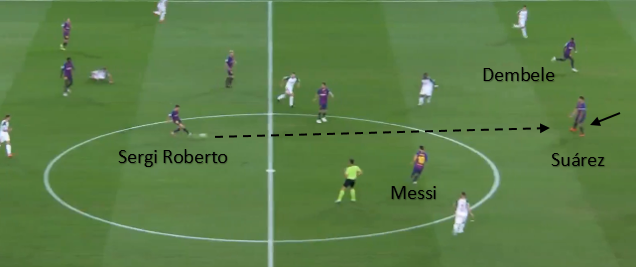
In this situation Luis Suárez came short for the ball between the lines while creating a clear line of pass that took three Alavés players out of the game. Before looking at the below diagrams, look how Messi is at an angle with both Sergi Roberto and Suárez. From this position Messi could receive a pass from Sergi Roberto or support Suárez in case Sergi Roberto decided to play the ball directly to Suárez. Messi’s open stance enables him to react and play the ball immediately should any of the mentioned options be executed.
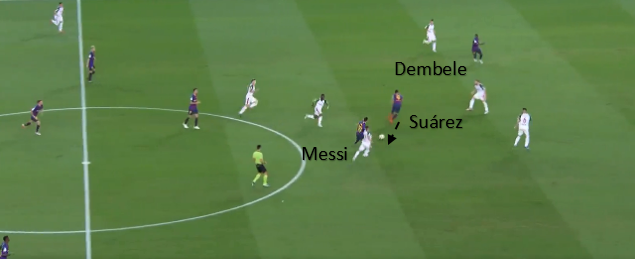
Sergi Roberto chose to play directly to Suárez who laid the ball off to Messi. Dembele’s stance told Messi that he was ready to receive the ball behind the defence. A key point here is that Dembele timed his run so not to get caught offside. In the above diagram Dembele is already offside, but he managed to get in line with the defence to initiate his run.
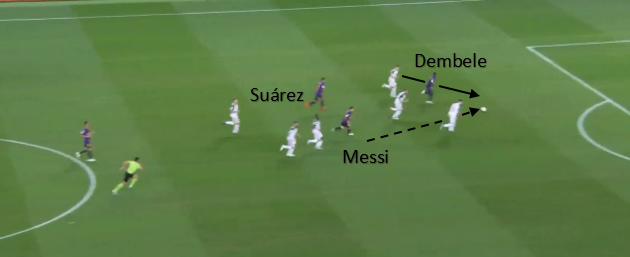
Messi managed to play an accurate well-weighted penetration pass. Take a note of Dembele’s run. The run is at an angle so to meet the ball on the run while facing the opposition’s goal.
Training exercise:
The following is an exercise with the aim of developing combination play in the middle channel, especially the up-back-through movement. However, this does not mean that only this movement will be performed throughout the exercise. Players will have to adjust accordingly if they want to pass to the player in zone 2 or to the player in zone 3. If the ball is played to the attacker in zone 2, he may play a wall-pass with the attacker in zone 3 prior to shooting on goal, thus developing another combination in attack. If the ball is played to the attacker in zone 3, he has to lay the ball for the attacker in zone 2 to finish on goal. The defender in zone 2 may intercept the passes played forward.
Setup:
Area: Zone 1 (12 yards x 15 yards), zone 2 (8 yards x 15 yards) and zone 3 (8 yards x 15 yards). Zone 3 is 16 yards away from goal.
Players: Three attackers in zone 1, one attacker in zone 2 and one attacker in zone 3. Two defenders in zone 1 and one defender in zone 2. A goalkeeper is positioned in a regular goal.
Duration:
Play in series of two minutes each with at least one minute rest in between. The total number of series to be played depends on the physical and tactical level of the players. You may also increase or decrease the duration of each series based on the same principle. Take into consideration the progressions to be used which will add to the mental and tactical intensity of the session.
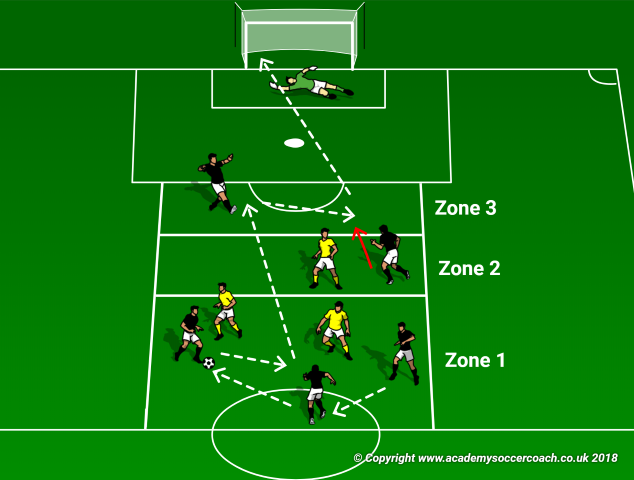
Progressions:
1. Play 3v3 in zone 1 while the attackers in zones 2 and 3 must continuously move to form passing angles.
2. Defender in zone 2 may track back to defend.
3. Defenders score on two mini goals positioned at the opposite end line. This forces the attackers to press immediately upon losing the ball.
4. Another defender from zone 3 may track back to defend. Therefore, another attacker from zone 3 may join the attack (see diagram below). In this progression we want another attacker from zone 1 to move to zone 2. The reason being that we want a player to apply pressure on the ball, and/or close passing lanes to prevent a counter attack in case possession is lost.
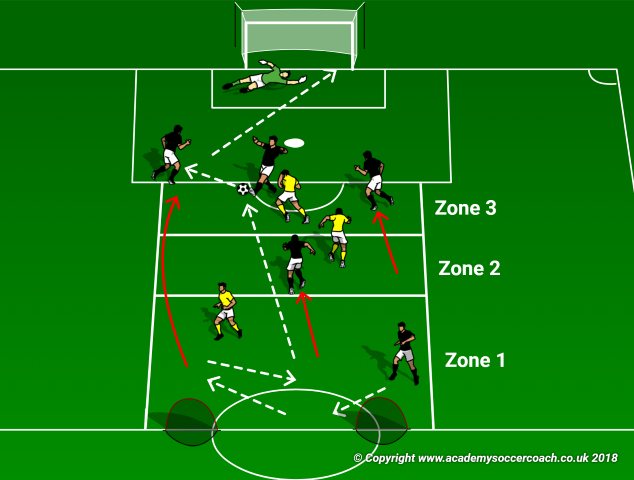
Philip Joe Cauchi works as performance coach in Malta. He holds a UEFA A and a UEFA A Youth Elite coaching licences as well as a B.ed (Hons) in Education with Physical Education and is also a qualified football conditioning coach.


